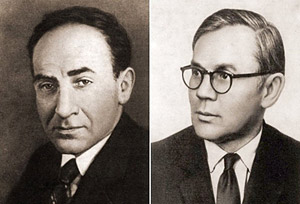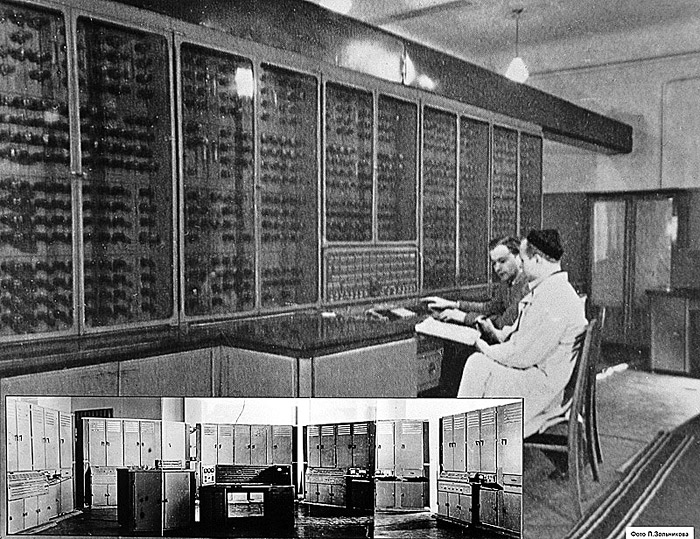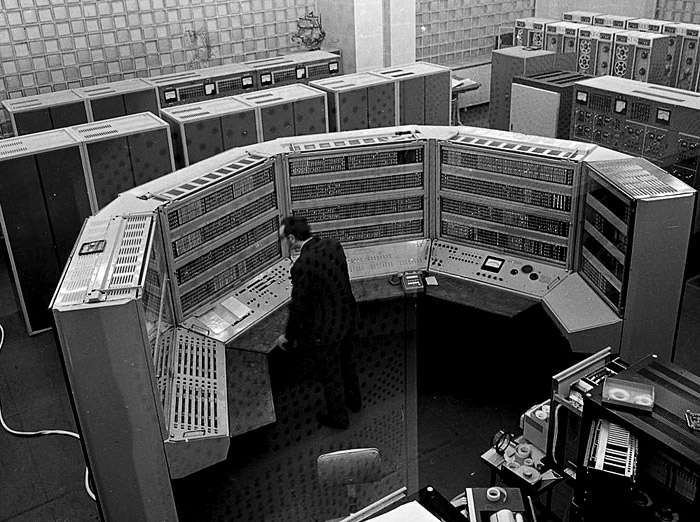
Electronic english version since 2022 |
The newspaper was founded in November 1957
| |
|
Number 46 (4694) |
They were the first
MLIT is ready for any challenge
On 4 December, 1948, corresponding member of the USSR Academy of Sciences Isaac Semenovich Brook and design engineer Bashir Iskanderovich Rameev submitted an application to the relevant State Committee of the Council of Ministers of the USSR for the invention of an automatic digital computer. This year, Russian information technology turns 75 years old.
 |
| I.S.Brook and B.I.Rameev |
On the eve of this date, Olga Tarantina asked MLIT Scientific Leader Vladimir Vasilievich Korenkov to talk about some episodes of the history of the Laboratory, its place in the IT sector of the country and the world, as well as to make some forecasts.
On 4 December, 1948, a patent for the invention of an automatic digital computer was registered. This date is considered the birthday of Soviet and Russian information technologies. Immediately after this event, the Institute of Precision Mechanics and Computer Engineering of the Russian Academy of Sciences (IPMCE) was established, headed by S.A.Lebedev, a star of the first magnitude. All our first computers were developed under him and the most important achievement was BESM-6 that became famous for centuries. At that moment, it was one of the three best computers in the world. The establishment of our laboratory also refers to it.
The Laboratory of Computer Science and Automation was established in 1966, but computer technology at JINR had appeared earlier, when the Department of Computational Mathematics and Calculating Machines had been organized at BLTP under E.P.Zhidkov and later, in 1963, a computer centre was established - mathematical divisions providing theoretical calculations and processing of experimental data, as well as a computer system concerning experimental facilities.

"Ural-1". 1958.
In 1958, the first Ural-1 machine was installed. Later, "Kiev", "Minsk", BESM appeared, on which, even before the organization of the computer centre, a lot of good work had been carried out, but the most impressive thing was the establishment of our first network in 1962, connecting the machines "Minsk" and "Kiev" in BLTP to FLNP. They laid a cable approximately one and a half kilometers long, through which information from the FLNP analyzers was transmitted. At that time, there were neither networks, nor Internet anywhere. The second historical event occurred in 1964, even before the establishment of the laboratory, when as part of one experiment, for the first time, a computer operated on the line and controlled the experiment. This project was headed by N.N.Govorun and I.A.Golutvin.
In 1966, a new Laboratory of Computer Science and Automation was established that included the Computing Centre, several departments and groups from other laboratories. When N.N.Bogolyubov invited M.G.Meshcheryakov to become its director, Mikhail Grigorievich was very puzzled. He was an experimental physicist. In 1946, in the USA, he listened to public lectures by the father of cybernetics Norbert Wiener that sank into his soul. He asked for three days to think and contacted the Plenipotentiary Representative of the USSR Government at JINR A.M.Petrosyants, to whom he told about this proposal and asked for appropriate funding. And having received support, three days later, he agreed. This is how the work of LCTA started. Automation was a very important component as it was mainly aimed at processing and scanning film information. Almost half of the new laboratory serviced computer technology, most of the second half processed film information and mathematicians were engaged in the development of numerical techniques and of software packages, primarily for processing film information. Many automatic and semi-automatic machines have been implemented for viewing film information.
Later, the era of electronic experiments started and our laboratory extensively participated in them, mainly, the team of I.M.Ivanchenko. Joseph Moiseevich did his first work with the greatest specialist that had developed software in the field of high energy physics Rene Bran (CERN). All software at CERN for many years has been made by him or under him. This is the famous HBook package, in the development of which Ivanchenko also took part. Afterwards, the packages developed and we, together with European colleagues, worked on the development of Cernov software that became basic for high energy physics. Many of our packages and programmes became part of the CERNLIB library that was transferred to us. We developed JINRLIB in parallel and many of our developments were very popular at CERN.

BESM-6. 1973.
And the most important hero at that time was BESM-6. N.N.Govorun had worked at CERN even before the establishment of LCTA and there he had become imbued with the ideas of the Fortran programming language. And in the USSR at that time the Algol language was promoted. It was a more correct context-free programming language and Fortran did not meet these canons. But a large amount of software had already been developed in Fortran, yet there was nothing in Algol and translator programme from Algol had not yet been written. Nikolay Nikolaevich spoke in support of Fortran at the Academy of Sciences, but no one approved of his idea. Nevertheless, he decided that in Dubna, his team would develop a FORTRAN translator, adapt the Cernov software and establish a regular system for automating scientific research, at least, in high energy physics. This was a very bold step on his part. Govorun went against the specialists whom he respected.
Life showed that it was the right choice. His team at LCTA developed the first translator programme from the Fortran language to BESM-6, the monitor system "Dubna", a set of subsystems of different programming languages, a system for launching and maintaining tasks, and adapted a large amount of software. This gave a strong impetus, so de facto monitor system "Dubna" quickly became a standard and later, the team of N.N.Govorun developed the operating system "Dubna". Many specialists contributed to the development of BESM-6: the ITMiCT team headed by S.A.Lebedev, the team of V.P.Ivannikov (they had developed six operating systems, this is a record), L.N.Korolev that is a famous personality in the field of software and operating systems for BESM-6, team of the M.V.Keldysh Institute of Applied Mathematics, Moscow State University and many others. A large cohort of basmachi, as they were called, developed around BESM-6. They had done a lot to bring this machine to a very good state in terms of software variety. This galaxy that developed BESM-6 became the leader of Russian information technologies.
Then, in our country, a not entirely right decision was made, perhaps, to copy Western machines and the ES series of computers appeared, compatible with the popular machines of the IBM family. It is clear that the BESM-6 line had to be developed in future, but it was not a mass-produced, elite machine. And in the 1970s, thousands of computers were needed and developing an appropriate production base was difficult. Perhaps, it was a necessary measure, but it somewhat weakened our position in the field of computer technologies. However, the BESM line continued to develop and many interesting ideas were implemented in it. For example, we made micro-BESM-6 in our laboratory. And if their mass production had been established, the BESM-6 line would have developed, but it was in the 1990s. And BESM-6 served in some places for another 20 years, because the software was very rich and they could not find an alternative to this machine.
An interesting stage started for us when the CDC-6500 machine appeared. It contributed to the development of computing technologies and to the understanding of what a modern operating system and modern interactive tools for users should look like. As a result, we started to develop a common interface for users on different machines; it was implemented on BESM, EC and CDC. The user was no longer tied to a specific machine. The first local terminal network JINET appeared and users began to access any machine in our complex from their terminal. It was very convenient. No one had local networks back then. Later, we acquired standard Ethernet when local networks and their standards appeared. We were the first in Russia to develop Internet channels. We had had two satellite channels before the Internet appeared in Russia. We organized one channel with the Dubna Space Communications Centre via satellite with the Gran Sasso National Laboratory (Italy) that was a node in the network for high energy physics HEPNet. It connected CERN, Bologna and other centres of Europe. Through this narrow neck of the 64 kbit/sec channel, we could work with CERN and other centres. Of course, it was almost impossible to send data over this channel; you could log in, type the programme and launch it. Later, the Internet appeared in Russia and we together with the Central Communications Service began to work on establishing a communication channel Moscow - Dubna, other channels appeared and we developed our communications. The era of big machines began to fade into history.
The 1990s were a transition period to find our identity and area for development. For me personally, this period was also difficult, because Nikolay Nikolaevich Govorun died. At the suggestion of M.G.Meshcheryakov, Rudolf Geintsevich Pose became Director of our Laboratory. He invited me to become deputy director to jointly determine a new vector for the Laboratory. Many personal computers have already appeared, everyone said: LCTA is not needed. But it was important not to lose all the accumulated experience. We understood that everything needed to be greatly restructured, the concept had to be changed. Gradually, we groped for new solutions, using mainly compact servers on RISC processors and personal computers. And in the second half of the 1990s, we began to develop clusters of personal machines: we placed them in rows and combined them into nodes of a "big machine." These years were a period of rapid development of web technologies that appeared in the late 1980s at CERN. We were one of the first to use them and the first site in Russian and Soviet web space was www.jinr.su. And here we were ahead in many ways. For example, we implemented the first interface that allows us to make the web dynamic: two of our specialists figured out how to make a request to databases via the web, get the result and visualize it. The dynamic web was born here in 1994 and only five years later, it began to be used widely in Oracle solutions.
Ending in the next issue.
Photo from the archive of the Meshcheryakov
Laboratory of Information Technologies